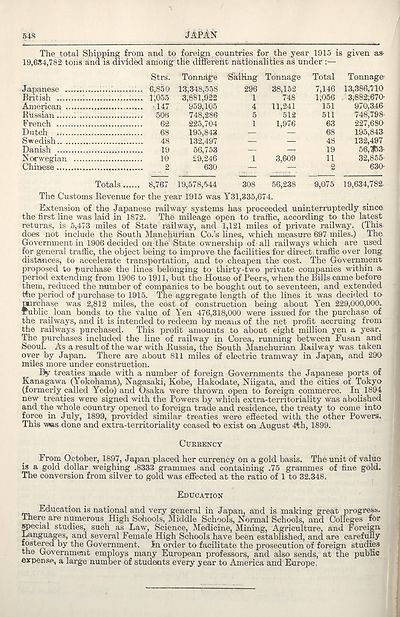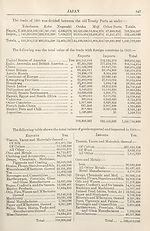1917
(628) Page 548
Download files
Complete book:
Individual page:
Thumbnail gallery: Grid view | List view

54S
JAPAN
The total Shipping from and to foreign countries for the year 1915 is given as-
19,684,782 tons and is divided among the different nationalities as under :—
Strs. Tonnage Sailing Tonnage Total Tonnage
Japanese ....1 6,850 13,348,558 296 38,152 7,146 13,386,710
British : i;055 3,881,922 1 748 1;056 3,882;670-
American vl47 959,105 4 11,241 151 970,346
Russian 506 748,286 5 512 511 748,798-
French 62 225,704 1 1,976 63 227,680
Dutch 68 195,843 — — 68 195,843
Swedish 48 132,497 — — 48 132,497
Danish 19 56,753 — — 19 56,?>3
Norwegian 10 29,246 1 3,609 11 32,855-
Chinese 2 630 — — 2 630-
Totals 8,767 19,578,544 308 56,238 9,075 19,634,782-
The Customs Revenue for the year 1915 was Y31,335,674.
Extension of the Japanese railway systems has proceeded uninterruptedly since
the first line was laid in 1872. The mileage open to traffic, according to the latest
returns, is 5,473 miles of State railway, and 1,121 miles of private railway. (This-
does not include the South Manchurian Co.’s lines, which measure 697 miles.) The
Government in 1906 decided on the State ownership of all railways which are used
for general traffic, the object being to improve the facilities for direct traffic over long,
distances, to accelerate transportation, and to cheapen the cost. The Government
proposed to purchase the lines belonging to thirty-two private companies within a.
period extending from 1906 to 1911, but the House of Peers, when the Bills came before
them, reduced the number of companies to be bought out to seventeen, and extended
ttie period of purchase to 1915. The aggregate length of the lines it was decided to-
purchase was 2,812 miles, the cost of construction being about Yen 229,000,000.
Tublic loan bonds to the value of Yen 476,318,000 were issued for the purchase of
the railways, and it is intended to redeem by means of the net profit accruing from
the railways purchased. This profit amounts to about eight million yen a year.
The purchases included the line of railway in Corea, running between Fusan and
Seoul. As a result of the war with Russia, the South Manchurian Railway was taken
oyer by Japan. There are about 811 miles of electric tramway in Japan, and 290
miles more under construction.
By treaties made with a number of foreign Governments the Japanese ports of
Kanagawa (Yokohama), Nagasaki, Kobe, Hakodate, Niigata, and the cities of Tokyo
(formerly called Yedo) and Osaka were thrown open to foreign commerce. In 1894
new treaties were signed with the Powers by which extra-territoriality was abolished
and the whole country opened to foreign trade and residence, the treaty to come into
force in July, 1899, provided similar treaties were effected with the other Powers.
This was done and extra-territoriality ceased to exist on August 4th, 1899.
Currency
From October, 1897, Japan placed her currency on a gold basis. The unit of value
is a gold dollar weighing .8333 grammes and containing .75 grammes of fine gold.
The conversion from silver to gold was effected at the ratio of 1 to 32.348.
Education
Education is national and very general in Japan, and is making great progress.
There are numerous High Schools,_ Middle Schools, Normal Schools, and Colleges for
special studies, such as Law, Science, Medicine, Mining, Agriculture, and Foreign
Languages, and several Female High Schools have been established, and are carefully
‘^stored by the Government. In order to facilitate the prosecution of foreign studies
the Government employs many European professors, and also sends, at the public
expense, a large number of students every year to America and Europe.
JAPAN
The total Shipping from and to foreign countries for the year 1915 is given as-
19,684,782 tons and is divided among the different nationalities as under :—
Strs. Tonnage Sailing Tonnage Total Tonnage
Japanese ....1 6,850 13,348,558 296 38,152 7,146 13,386,710
British : i;055 3,881,922 1 748 1;056 3,882;670-
American vl47 959,105 4 11,241 151 970,346
Russian 506 748,286 5 512 511 748,798-
French 62 225,704 1 1,976 63 227,680
Dutch 68 195,843 — — 68 195,843
Swedish 48 132,497 — — 48 132,497
Danish 19 56,753 — — 19 56,?>3
Norwegian 10 29,246 1 3,609 11 32,855-
Chinese 2 630 — — 2 630-
Totals 8,767 19,578,544 308 56,238 9,075 19,634,782-
The Customs Revenue for the year 1915 was Y31,335,674.
Extension of the Japanese railway systems has proceeded uninterruptedly since
the first line was laid in 1872. The mileage open to traffic, according to the latest
returns, is 5,473 miles of State railway, and 1,121 miles of private railway. (This-
does not include the South Manchurian Co.’s lines, which measure 697 miles.) The
Government in 1906 decided on the State ownership of all railways which are used
for general traffic, the object being to improve the facilities for direct traffic over long,
distances, to accelerate transportation, and to cheapen the cost. The Government
proposed to purchase the lines belonging to thirty-two private companies within a.
period extending from 1906 to 1911, but the House of Peers, when the Bills came before
them, reduced the number of companies to be bought out to seventeen, and extended
ttie period of purchase to 1915. The aggregate length of the lines it was decided to-
purchase was 2,812 miles, the cost of construction being about Yen 229,000,000.
Tublic loan bonds to the value of Yen 476,318,000 were issued for the purchase of
the railways, and it is intended to redeem by means of the net profit accruing from
the railways purchased. This profit amounts to about eight million yen a year.
The purchases included the line of railway in Corea, running between Fusan and
Seoul. As a result of the war with Russia, the South Manchurian Railway was taken
oyer by Japan. There are about 811 miles of electric tramway in Japan, and 290
miles more under construction.
By treaties made with a number of foreign Governments the Japanese ports of
Kanagawa (Yokohama), Nagasaki, Kobe, Hakodate, Niigata, and the cities of Tokyo
(formerly called Yedo) and Osaka were thrown open to foreign commerce. In 1894
new treaties were signed with the Powers by which extra-territoriality was abolished
and the whole country opened to foreign trade and residence, the treaty to come into
force in July, 1899, provided similar treaties were effected with the other Powers.
This was done and extra-territoriality ceased to exist on August 4th, 1899.
Currency
From October, 1897, Japan placed her currency on a gold basis. The unit of value
is a gold dollar weighing .8333 grammes and containing .75 grammes of fine gold.
The conversion from silver to gold was effected at the ratio of 1 to 32.348.
Education
Education is national and very general in Japan, and is making great progress.
There are numerous High Schools,_ Middle Schools, Normal Schools, and Colleges for
special studies, such as Law, Science, Medicine, Mining, Agriculture, and Foreign
Languages, and several Female High Schools have been established, and are carefully
‘^stored by the Government. In order to facilitate the prosecution of foreign studies
the Government employs many European professors, and also sends, at the public
expense, a large number of students every year to America and Europe.
Set display mode to:
![]() Universal Viewer |
Universal Viewer | ![]() Mirador |
Large image | Transcription
Mirador |
Large image | Transcription
Images and transcriptions on this page, including medium image downloads, may be used under the Creative Commons Attribution 4.0 International Licence unless otherwise stated. ![]()
| Asian directories and chronicles > 1917 > (628) Page 548 |
|---|
| Permanent URL | https://digital.nls.uk/194540472 |
|---|
| Attribution and copyright: |
|
|---|---|
| Description | Volumes from the Asian 'Directory and Chronicle' series covering 1917-1941, but missing 1919 and 1923. Compiled annually from a multiplicity of local sources and research. They provide listings of each country's active corporations, foreign residents and government agencies of all nationalities for that year, together with their addresses. Content includes: various treaties; coverage of conflicts; currencies and taxes; consular fees; weights and measures; public holidays; festivals and traditions. A source of information for both Western states and communities of foreigners living in Asia. Published by Hongkong Daily Press. |
|---|---|
| Shelfmark | H3.86.1303 |
| Additional NLS resources: |

![[Page 549]Tokyo](https://deriv.nls.uk/dcn4/1945/4048/194540487.4.jpg)